TOYOTA VENZA 2013 Owners Manual (in English)
Manufacturer: TOYOTA, Model Year: 2013, Model line: VENZA, Model: TOYOTA VENZA 2013Pages: 556, PDF Size: 10.4 MB
Page 261 of 556
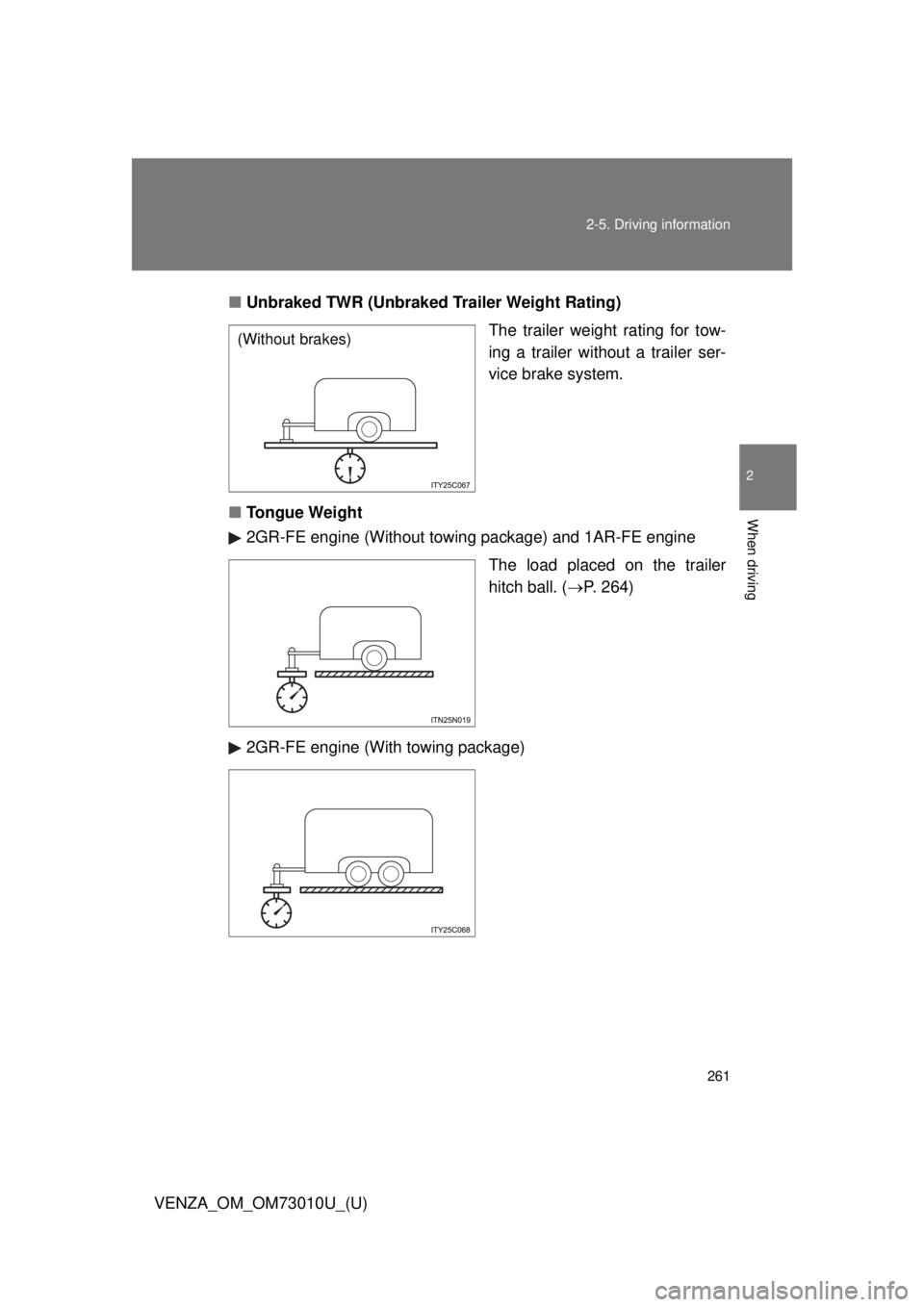
261
2-5. Driving information
2
When driving
VENZA_OM_OM73010U_(U)
■
Unbraked TWR (Unbraked Trailer Weight Rating)
The trailer weight rating for tow-
ing a trailer without a trailer ser-
vice brake system.
■ Tongue Weight
2GR-FE engine (Without towing package) and 1AR-FE engine
The load placed on the trailer
hitch ball. ( P. 264)
2GR-FE engine (With towing package)
(Without brakes)
Page 262 of 556
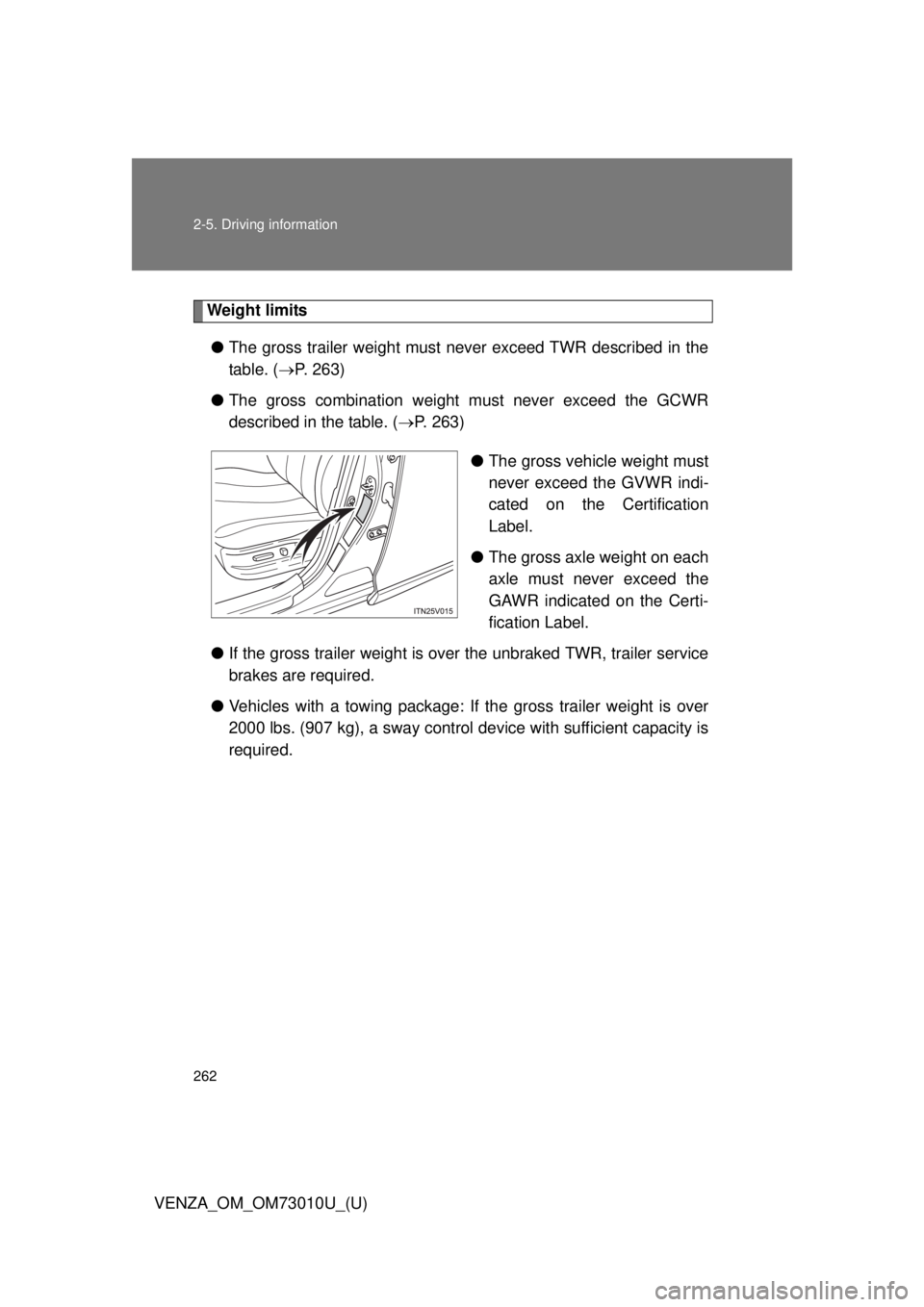
262 2-5. Driving information
VENZA_OM_OM73010U_(U)
Weight limits● The gross trailer weight must never exceed TWR described in the
table. ( P. 263)
● The gross combination weight must never exceed the GCWR
described in the table. ( P. 263)
●The gross vehicle weight must
never exceed the GVWR indi-
cated on the Certification
Label.
● The gross axle weight on each
axle must never exceed the
GAWR indicated on the Certi-
fication Label.
● If the gross trailer weight is over the unbraked TWR, trailer service
brakes are required.
● Vehicles with a towing package: If the gross trailer weight is over
2000 lbs. (907 kg), a sway control device with sufficient capacity is
required.
Page 263 of 556
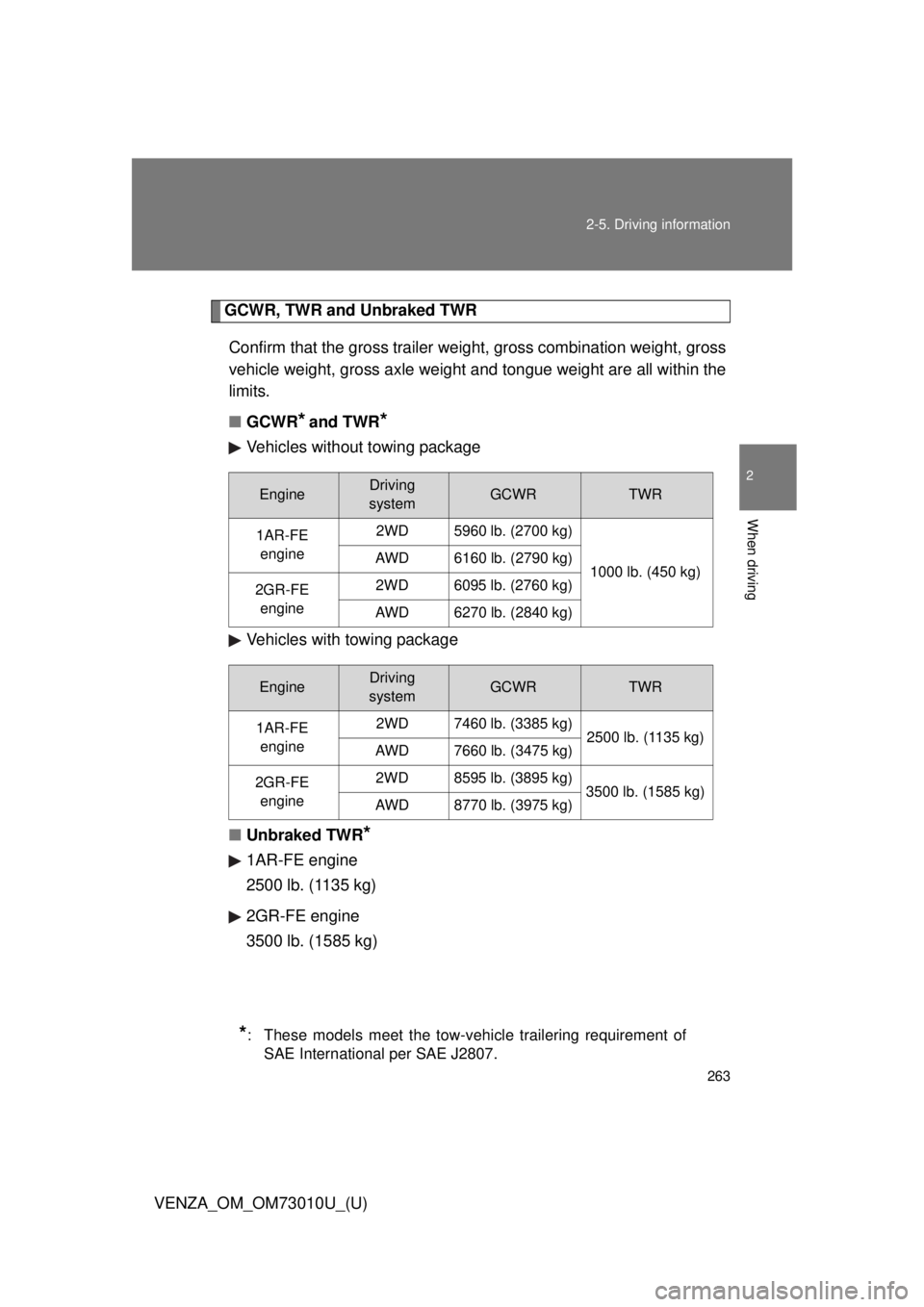
263
2-5. Driving information
2
When driving
VENZA_OM_OM73010U_(U)
GCWR, TWR and Unbraked TWR
Confirm that the gross trailer weight, gross combination weight, gross
vehicle weight, gross axle weight and tongue weight are all within the
limits.
■ GCWR
*and TWR*
Vehicles without towing package
Vehicles with towing package
■ Unbraked TWR
*
1AR-FE engine
2500 lb. (1135 kg)
2GR-FE engine
3500 lb. (1585 kg)
*: These models meet the tow-vehicle trailering requirement of
SAE Internationa l per SAE J2807.
EngineDriving
systemGCWRTWR
1AR-FE engine 2WD 5960 lb. (2700 kg)
1000 lb. (450 kg)
AWD 6160 lb. (2790 kg)
2GR-FE engine 2WD 6095 lb. (2760 kg)
AWD 6270 lb. (2840 kg)
EngineDriving
systemGCWRTWR
1AR-FE engine 2WD 7460 lb. (3385 kg)
2500 lb. (1135 kg)
AWD 7660 lb. (3475 kg)
2GR-FE engine 2WD 8595 lb. (3895 kg)
3500 lb. (1585 kg)
AWD 8770 lb. (3975 kg)
Page 264 of 556
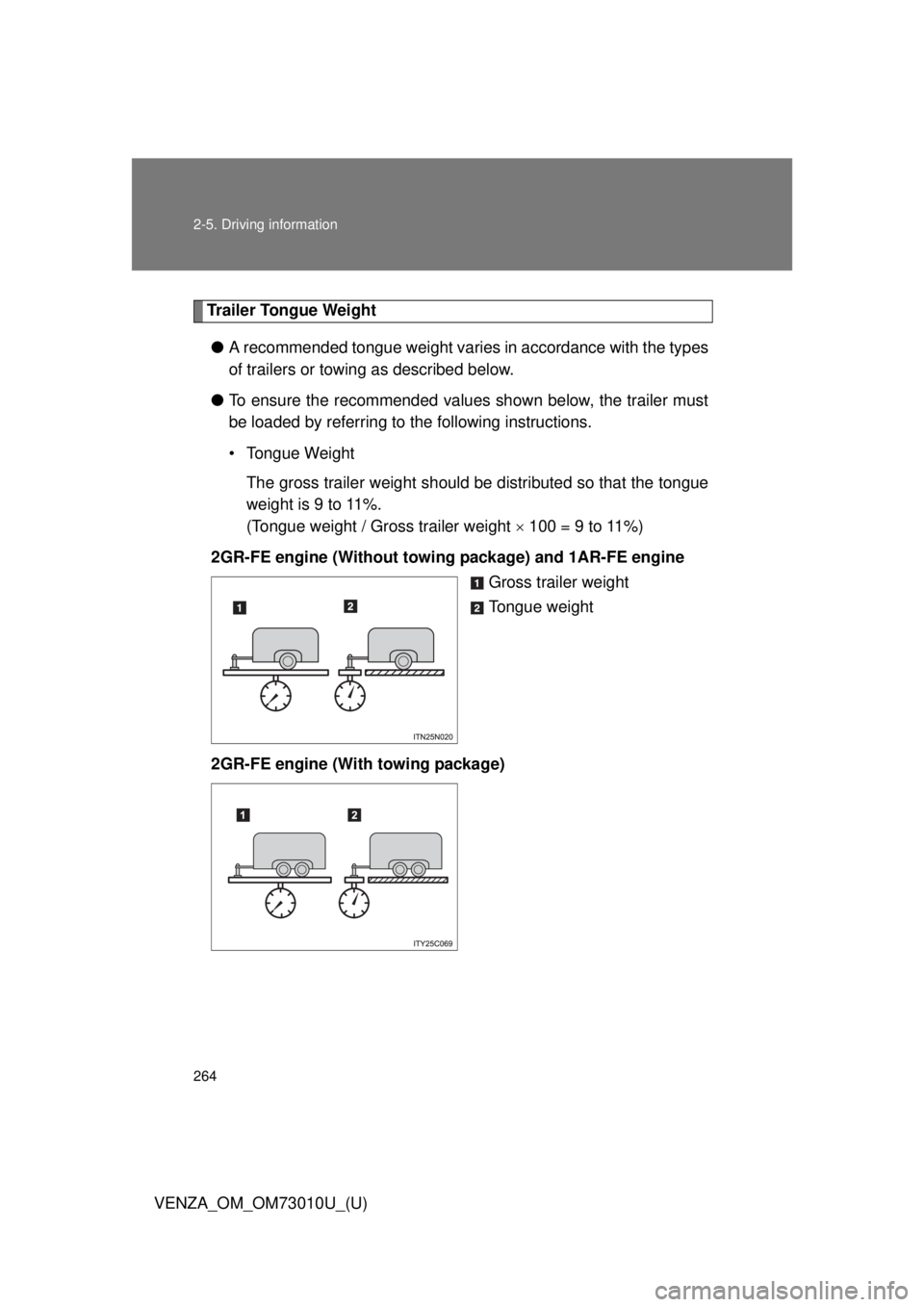
264 2-5. Driving information
VENZA_OM_OM73010U_(U)
Trailer Tongue Weight● A recommended tongue weight varies in accordance with the types
of trailers or towing as described below.
● To ensure the recommended values shown below, the trailer must
be loaded by referring to the following instructions.
• Tongue Weight
The gross trailer weight should be distributed so that the tongue
weight is 9 to 11%.
(Tongue weight / Gross trailer weight 100 = 9 to 11%)
2GR-FE engine (Without towi ng package) and 1AR-FE engine
Gross trailer weight
Tongue weight
2GR-FE engine (With towing package)
Page 265 of 556

265
2-5. Driving information
2
When driving
VENZA_OM_OM73010U_(U)
If using a weight distributing hitch when towing, return the front
axle to the same weight as before the trailer connection.
If front axle weight cannot be
measured directly, measure the front
fender height above the front axle before connection. Adjust weight
distributing hitch torque until fr ont fender is returned to the same
height as before connection.
The gross trailer weight, gross axle weight and tongue weight can
be measured with platform scales found at a highway weighing sta-
tion, building supply company, trucking company, junk yard, etc.
Hitch
Trailer hitch assemblies have different weight capacities. Toyota rec-
ommends the use of Toyota hitch/brac ket for your vehicle. For details,
contact your Toyota dealer.
● If you wish to install a trailer hitch, contact your Toyota dealer.
● Use only a hitch that conforms to the gross trailer weight require-
ment of your vehicle.
● Follow the directions supplied by the hitch manufacturer.
● Lubricate the hitch ball with a light coating of grease.
● Remove the trailer hitch whenever you are not towing a trailer.
After removing the hitch, seal any mounting hole in the vehicle
body to prevent entry of any substances into the vehicle.
Page 266 of 556
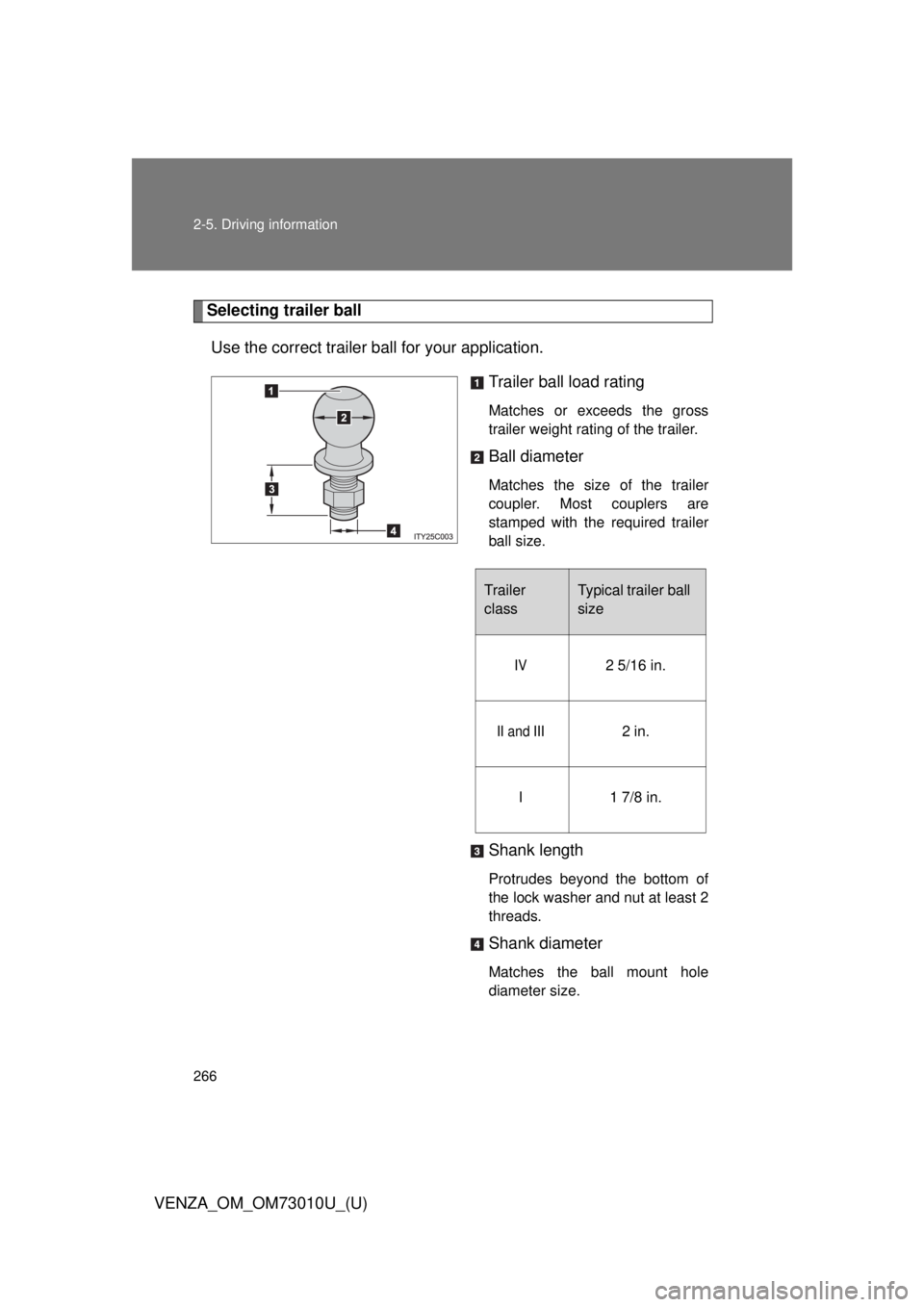
266 2-5. Driving information
VENZA_OM_OM73010U_(U)
Selecting trailer ballUse the correct trailer ball for your application. Trailer ball load rating
Matches or exceeds the gross
trailer weight rating of the trailer.
Ball diameter
Matches the size of the trailer
coupler. Most couplers are
stamped with the required trailer
ball size.
Shank length
Protrudes beyond the bottom of
the lock washer and nut at least 2
threads.
Shank diameter
Matches the ball mount hole
diameter size.
Trailer
classTypical trailer ball
size
IV2 5/16 in.
II and III2 in.
I1 7/8 in.
Page 267 of 556
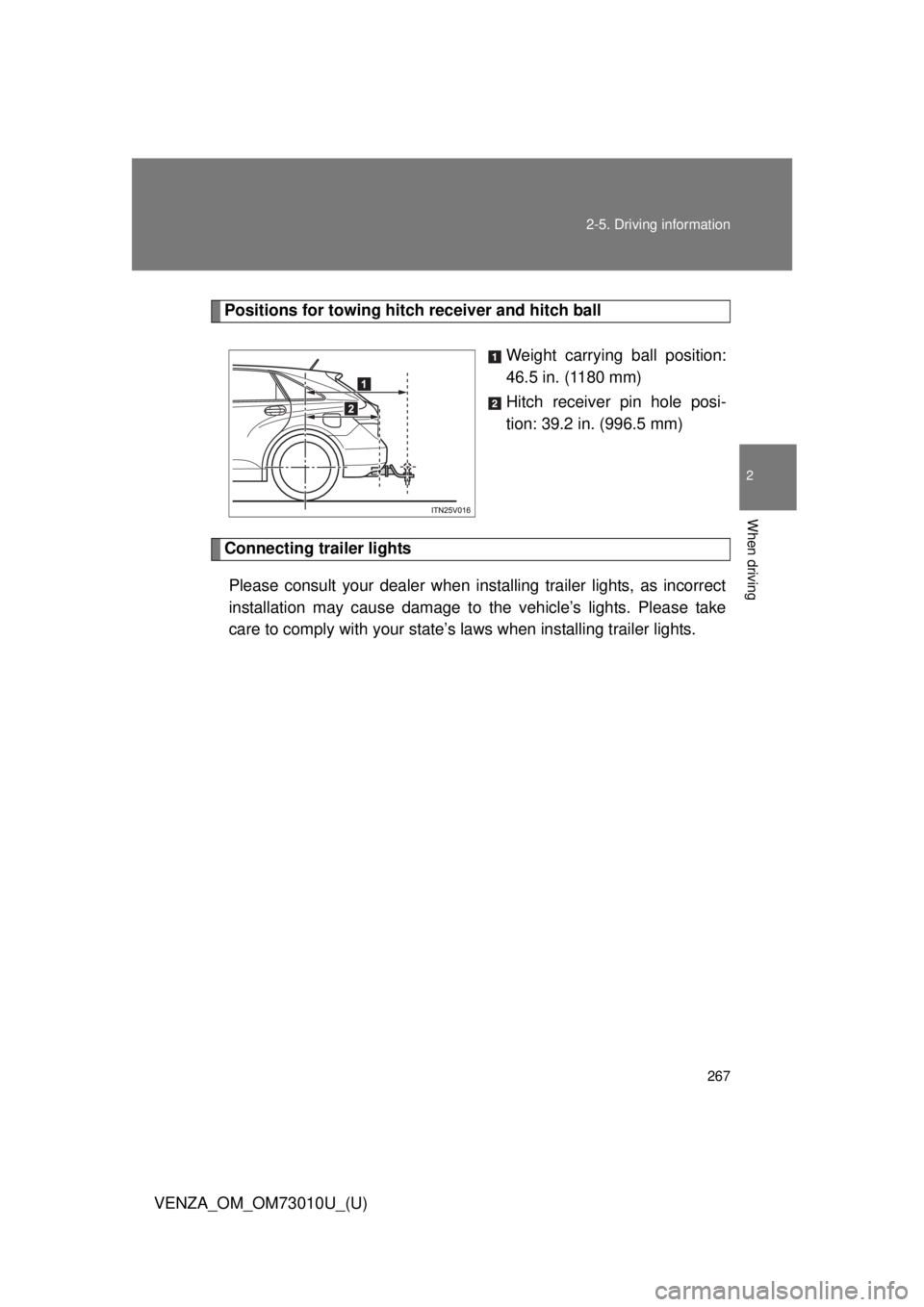
267
2-5. Driving information
2
When driving
VENZA_OM_OM73010U_(U)
Positions for towing hitch
receiver and hitch ball
Weight carrying ball position:
46.5 in. (1180 mm)
Hitch receiver pin hole posi-
tion: 39.2 in. (996.5 mm)
Connecting trailer lightsPlease consult your dealer when installing trailer lights, as incorrect
installation may cause damage to the vehicle’s lights. Please take
care to comply with your state’ s laws when installing trailer lights.
Page 268 of 556

268 2-5. Driving information
VENZA_OM_OM73010U_(U)
Trailer towing tipsYour vehicle will handle differently when towing a trailer. Help to avoid
an accident, death or serious injury, keep the following in mind when
towing:
● Speed limits for towing a trailer vary by state or province. Do not
exceed the posted towing speed limit.
● Toyota recommends that the vehicle-trailer speed limit is 65 mph
(104 km/h) on a flat, straight, dry road. Do not exceed this limit, the
posted towing speed limit or the speed limit for your trailer as set
forth in your trailer owner’s man ual, whichever is lowest. Instability
of the towing vehicle-trailer combin ation (trailer sway) increases as
speed increases. Exceeding speed limits may cause loss of con-
trol.
● Before starting out, check the trailer lights, tires and the vehicle-
trailer connections. Recheck after driving a short distance.
● Practice turning, stopping and reve rsing with the trailer attached in
an area away from traffic until you become accustomed to the feel
of the vehicle-trailer combination.
● Reversing with a trailer attached is difficult and requires practice.
Grip the bottom of the steering wheel and move your hand to the
left to move the trailer to the left. Move your hand to the right to
move the trailer to the right. (This is generally opposite to reversing
without a trailer attached.) Avoid sharp or prolonged turning. Have
someone guide you when reversing to reduce the risk of an acci-
dent.
Page 269 of 556

269
2-5. Driving information
2
When driving
VENZA_OM_OM73010U_(U)
●
As stopping distance is increased when towing a trailer, vehicle-to-
vehicle distance should be increased. For each 10 mph (16 km/h) of
speed, allow at least one vehicle and trailer length.
● Avoid sudden braking as you may skid, resulting in the trailer jack-
knifing and a loss of vehicle control. This is especially true on wet
or slippery surfaces.
● Avoid jerky starts or sudden acceleration.
● Avoid jerky steering and sharp turns, and slow down before mak-
ing a turn.
● Note that when making a turn, th e trailer wheels will be closer than
the vehicle wheels to the inside of the turn. Compensate by making
a wider than normal turning radius.
● Slow down before making a turn, in crosswinds, on wet or slippery
surfaces, etc.
Increasing vehicle speed can destabilize the trailer.
● Take care when passing other vehicles. Passing requires consider-
able distance. After passing a vehicle, do not forget the length of
your trailer, and be sure you hav e plenty of room before changing
lanes.
● To maintain engine braking efficiency and charging system perfor-
mance when using engine braking, do not put the transmission in
D.
Transmission shift range position must be in 4 in the S mode.
● Instability happens more frequently when descending steep or long
downhill grades. Before descending, slow down and downshift. Do
not make sudden downshifts while descending steep or long down-
hill grades.
Page 270 of 556

270 2-5. Driving information
VENZA_OM_OM73010U_(U)●
Avoid holding the brake pedal down too long or applying the
brakes too frequently. This could cause the brakes to overheat and
result in reduced braking efficiency.
● Due to the added load of the trailer, your vehicle’s engine may
overheat on hot days (at temper atures over 85°F [30°C]) when
driving up a long or steep grade. If the Engine coolant temperature
gauge indicates overheating, immediately turn off the air condition-
ing (if in use), pull your vehicle off the road and stop in a safe spot.
( P. 471)
● Always place wheel blocks under both the vehicle’s and the
trailer’s wheels when parking. Ap ply the parking brake firmly, and
put the transmission in P. Avoid parking on a slope, but if unavoid-
able, do so only after performing the following:
Apply the brakes and keep them applied.
Have someone place wheel blo cks under both the vehicle’s
and trailer’s wheels.
When the wheel blocks are in place, release the brakes slowly
until the blocks absorb the load.
Apply the parking brake firmly.
Shift into P and turn off the engine.
STEP1
STEP2
STEP3
STEP4
STEP5